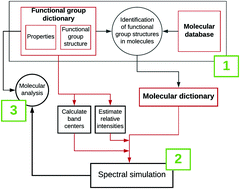Molecular simulations for the spectroscopic detection of atmospheric gases
Abstract
Unambiguously identifying molecules in spectra is of fundamental importance for a variety of scientific and industrial uses. Interpreting atmospheric spectra for the remote detection of volatile compounds requires information about the spectrum of each relevant molecule. However, spectral data currently exist for a few hundred molecules and only a fraction of those have complete spectra (e.g. H2O, NH3). Consequently, molecular detections in atmospheric spectra remain vulnerable to false positives, false negatives, and missassignments. There is a key need for spectral data for a broad range of molecules. Given how challenging it is to obtain high-resolution molecular spectra, there is great value in creating intermediate approximate spectra that can provide a starting point for the analysis of atmospheric spectra. Using a combination of experimental measurements, organic chemistry, and quantum mechanics, RASCALL (Rapid Approximate Spectral Calculations for ALL) is a computational approach that provides approximate spectral data for any given molecule, including thousands of potential atmospheric gases. RASCALL is a new theoretical chemistry method for the simulation of spectral data. RASCALL 1.0, presented here, is capable of simulating molecular spectral data, in a few seconds, by interpreting functional group data from experimental and theoretical sources to estimate the position and strength of molecular bands. The RASCALL 1.0 spectra consist of approximate band centers and qualitative intensities. RASCALL 1.0 is also able to assess hundreds of molecules simultaneously, which will inform prioritization protocols for future, computationally and experimentally costly, high-accuracy physical chemistry studies. Finally, RASCALL can be used to study spectral patterns between molecules, highlighting ambiguities in molecular detections and also directing observations towards spectral regions that reduce the degeneracy in molecular identification. The RASCALL catalogue, and its preliminary version RASCALL 1.0, contains spectral data for more molecules than any other publicly available database, with applications in all fields interested in the detection of molecules in the gas phase (e.g., medical imaging, petroleum industry, pollution monitoring, astrochemistry). The preliminary catalogue of molecular data and associated documentation are freely available online and will be routinely updated.

- This article is part of the themed collection: 2019 PCCP HOT Articles


 Please wait while we load your content...
Please wait while we load your content...